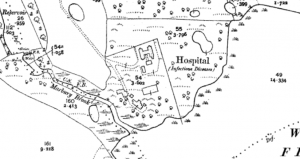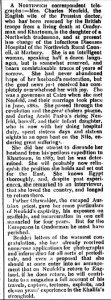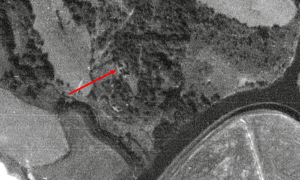From the late 1890s, a hospital for infectious diseases begins to appear on maps close to what is now the confluence of Marbury Brook and Witton Brook, a few hundred metres southwest of the present day Haydn Pool nature reserve. The hospital structure doesnt appear on any maps previous to this, suggesting that it was constructed somewhere between 1885 and 1895. The hospital was constructed on the very edge of Witton Flash this flash has since receded, re-establishing the course of Witton Brook.
In 1898, there were numerous fleeting references to the hospital in the world’s press, namely because of Charlotte Emma Neufeld, who, at the time, was a matron at the hospital. Charlotte Neufeld, née Netherton, was the daughter of a Northwich tradesman. Charlotte married the Austrian civil contractor Charles Neufeld in Cairo, 1880. Their daughter, Evelyn, was born in Cairo later that year. Whilst in Egypt, Charles worked as a civil contractor undertaking work for the British army. In 1887, Charles loaded a vessel full of European merchandise and set sail for Khartoum, Sudan his intentions were to undertake trade and to then return to his wife and young daughter in Cairo. However, Charles was captured by rebels whilst in the city of Omdurman. Charles was imprisoned and subsequently tortured by his captors. As the days, months and years passed, Charlotte grew resigned to the fact that her husband would never return. In the early 1890s, Charlotte and Evelyn moved to Greece, where Charlotte worked as a nurse. In the mid-1890s, Charlotte and her daughter returned to England where she took the post of chief matron at the Marbury hospital for infectious diseases.
In 1898, led by General Kitchener, the Battle of Omdurman ensued and against all odds, Charles Neufeld was found alive, still in captivity. Charles had endured twelve years of torture and appalling conditions. News soon reached Charlotte and her daughter, Evelyn, that Charles was indeed still alive. Aged eighteen, Evelyn was now working alongside her mother at the Marbury hospital. As referenced in The Church Weekly, Charlotte is described as an intelligent woman, speaking half a dozen languages, but is somewhat reserved, and bears unmistakeable traces of years of sorrow. She had never abandoned hope of her husbands restoration, but the good news just received has completely overwhelmed her with joy. The article goes onto note that, with the arrival of such news, Charlotte was likely to now leave her post as matron and return to Egypt to be reunited with her husband.
Later that year, this remarkable story had spread across the globe. Indeed, by November 1898, the story was even included in the New Zealand Thames Star newspaper, viewable here. Records indicate that Charlotte and Evelyn both went to Egypt to be reunited with Charles and that the three of them soon returned to England. Around the turn of the century, Charles began delivering lectures in both England and across Europe. The National Portrait Gallery even has a photograph of Charles, viewable here – he is listed as the prisoner of Omdurman. From this point onwards, records on Charles, Charlotte and Evelyn are scarce.
With this remarkable story aside, it would appear that, post 1900, the hospital began to specialise in the isolation of those with smallpox. Indeed, the hospital is listed in the Annual Report of the Registrar-General for England and Wales, 1908, as the Small-pox Hospital, Marbury alongside other isolation hospitals in the Northwich area. Other than this, there is very little reference to the hospital in any archives.

The Small-Pox Hospital, Marbury. Annual Report of the Registrar-General for England and Wales, 1908
The hospital is visible, albeit in low resolution, on aerial photography from 1945. From the photograph below, it appears as though the main hospital structure is the H-shaped building to the north of the site. Old maps indicate that there were numerous ancillary buildings within the wooded grounds. The building still appears on maps in 1954, although it is no longer denoted as a hospital. By the 1960s the structures no longer appear on any maps, indicating that they were demolished sometime between 1955 and 1965.


